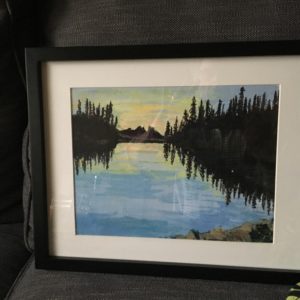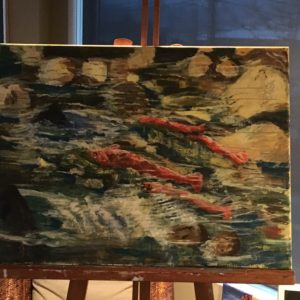What You See Is Not Always What You Think You See
One of the things I find most challenging about painting — and most wonderful — is trying to draw and paint what I see, not what I think I see.
We all have conceptual pictures in our minds of all sorts of things, e.g. a tree, a face, a table or a distant mountain. As I’ve learned a bit about drawing and painting the task is, as in much learning, first of all to do some un-learning. You have to unlearn or unhook from the mental construct or concept of what you think you see, whether a table or a tree, and try to draw or paint what you are actually seeing.
 When you manage to do the latter the result is often surprising. What looks as if it doesn’t work or make sense, turns out to be just the opposite.
When you manage to do the latter the result is often surprising. What looks as if it doesn’t work or make sense, turns out to be just the opposite.
As an example, here’s a recent painting of mine of Grace Lake in the Alpine Lakes Wilderness Area in the Cascades. On my first time or two I painted something, of the two stands of trees darkened by the sunset behind them, that ended up looking like a hedgehog or porcupine with needles (if you still think that’s how it looks, just keep that to yourself!). A solid mass of the hillside with a bunch of skinny trees lines sprouting out like hair or quills. Finally, I realized that this wasn’t what I was seeing. I was seeing more like an ink blot in which hillside and trees, and their reflection in the lake, were merged and mingled.
It strikes me that this lesson from painting about seeing and painting what you are actually seeing, which may be — almost certainly is — different than what you think you are seeing, has broader application. So often what we think is going on with a person or in a situation may be only a mental shorthand that we place on what we’re experiencing. Deeper listening may reveal something other than we thought.
I also notice a somewhat parallel difference in writing of fiction (which I don’t do or haven’t as yet). I mentioned recently that I read mysteries while on the exercise machines at Ballard Health Club. Many of the most popular works in the mystery/ thriller genre tend to rely on stereotypes and resort to cliches. If there’s a phrase that in a certain situation is the expected cliche that is what you are likely to get in B (as in grade B but also “best-selling”) fiction. This means we don’t have to work so hard or think so much as we read. But it also makes such fiction less interesting and less evocative. It’s called “beach reading” for a reason. It doesn’t ask much of us.
The writers who don’t give us the expected stereotype or predictable cliche, but who help us to see things with more shading and complexity, not to mention, surprise are more engaging, memorable and truthful. They too help us to see and observe more carefully. They show life to be more unpredictable, complex and uncertain than many of thrillers that have spent X number of weeks on the best-seller list and sold X millions of copies.
Who was it who said that good writing requires killing your “little darlings”? Faulkner, maybe? You may have written something that you really love, but it doesn’t in the end add to whole or quite fit. Kill it. Strike it. How sad, how painful. Sometimes true in sermons. You really like some line or some anecdote, but it doesn’t really fit or help. Sorry.
 And sometimes in painting too. For example, another recent work of mine is a painting of spawning Kokanee salmon in the Wallowa River. On the largest fish I had a fine and distinct fisheye looking directly at the viewer. I really liked it. But it was all wrong. Because in reality the viewer is looking down at the fish in the water. What you see is not a full on fisheye, as if the fish had stopped and rolled half over to give you the once over, but only a glint of black and gold turning away. I was sorry to lose that nice fisheye, but it wasn’t what I saw, not honestly. Here’s that painting, still in progress.
And sometimes in painting too. For example, another recent work of mine is a painting of spawning Kokanee salmon in the Wallowa River. On the largest fish I had a fine and distinct fisheye looking directly at the viewer. I really liked it. But it was all wrong. Because in reality the viewer is looking down at the fish in the water. What you see is not a full on fisheye, as if the fish had stopped and rolled half over to give you the once over, but only a glint of black and gold turning away. I was sorry to lose that nice fisheye, but it wasn’t what I saw, not honestly. Here’s that painting, still in progress.
I think it was Mark Twain who said the difference between the almost right word and the right word was the difference between a lightning bug and lightening. That’s a similar point. Struggling to write and paint what you really see as opposed to your convenient mental concept or construct.
That said, I do love lightning bugs.
![Anthony B. Robinson [logo]](https://www.anthonybrobinson.com/wp-content/themes/anthonybrobinson/images/logo.png)
![Anthony B. Robinson [logo]](https://www.anthonybrobinson.com/wp-content/themes/anthonybrobinson/images/logo-print.png)
